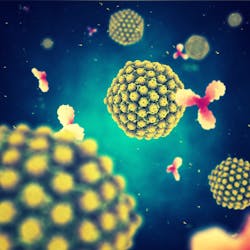Comparison of SARS-CoV-2 antibody response in incrementally immunosuppressed patients
This study, reported in the journal JAMA, compares antispike antibody titers after the 2-dose mRNA-1273 and BNT162b2 vaccines in incrementally immunosuppressed patients, according to a news release.
Both mRNA-1273 and BNT162b2 SARS-CoV-2 vaccines elicit immune responses consistent with viral neutralization in most immunocompetent persons. Immunosuppressed individuals, such as persons with rheumatic and musculoskeletal diseases (RMDs) and solid organ transplant recipients (SOTRs), have decreased immune responses to these vaccines. Thus, differential vaccine immunogenicity is clinically relevant in ways not seen in immunocompetent persons.
Patients with RMDs and SOTRs without prior positive SARS-CoV-2 test results were recruited to this cohort study. Participants receiving 2 SARS-CoV-2 messenger RNA (mRNA) doses between December 16, 2020, and July 6, 2021, were included. This study followed the STROBE reporting guideline for observational studies and was approved by the Johns Hopkins Institutional Review Board. Patients provided informed consent electronically.
Semiquantitative testing for antibodies against the receptor binding domain (RBD) of the SARS-CoV-2 spike protein was performed using the Roche Elecsys anti–SARS-CoV-2 S enzyme immunoassay 15 to 45 days after the second dose. Anti-RBD titers were divided into 50, 100, and 250 U/mL or greater based on levels associated with incremental plasma neutralizing capacity in patients convalescing from COVID-19 and a modeling study across COVID-19 vaccine trials. Participants were stratified by increasing intensity of immunosuppression: patients with RMDs not receiving immunosuppression or receiving hydroxychloroquine or intravenous immunoglobulin, patients with RMDs receiving immunosuppression, SOTRs not receiving mycophenolic acid or mycophenolate mofetil, and SOTRs receiving mycophenolic acid or mycophenolate mofetil. Immunosuppression intensity was defined by the presence or absence of baseline immune dysregulation and data on SARS-CoV-2 vaccination antibody response. Response rates were compared between mRNA-1273 and BNT162b2 recipients using modified Poisson regression weighted for age, time since vaccination, and number of immunosuppressive medications and repeated this analysis for positive response thresholds of 50, 100, and 250 U/mL.
Participant characteristics were compared using the Wilcoxon rank sum test for continuous and Fisher exact test for categorical variables. A 2-sided P < .05 was considered significant. Analyses were performed using Stata/SE, version 17.0.
This cohort included 1158 participants with RMDs and 697 SOTRs: 647 patients with RMDs (55.8%) and 367 SOTRs (52.7%) received BNT162b2; the remainder received mRNA-1273. Among the 220 participants with RMDs not receiving immunosuppression, hydroxychloroquine, or intravenous immunoglobulin, the rate of anti-RBD titers of 250 U/mL or greater was comparable among BNT162b2 (108/118 [91.5%]) and mRNA-1273 (95/102 [93.1%]) recipients (incidence rate ratio [IRR], 1.02; 95% CI, 0.94-1.10; P = .69). However, mRNA-1273 recipients had higher rates of anti-RBD titers of 250 U/mL or greater than BNT162b2 recipients among the 938 patients with RMDs receiving immunosuppression (324/409 [79.2%] vs 320/529 [60.5%]; IRR, 1.30; 95% CI, 1.20-1.43; P<.001), 260 SOTRs not receiving mycophenolic acid or mycophenolate mofetil (85/128 [66.4%] vs 59/132 [44.7%]; IRR, 1.56; 95% CI, 1.24-1.96; P<.001), and 437 SOTRs receiving mycophenolic acid or mycophenolate mofetil (23/202 [11.4%] vs 10/235 [4.3%]; IRR, 2.62; 95% CI, 1.28-5.37; P = 0.01). Similar trends were observed with the other cutoffs.
Similar seroresponses to mRNA-1273 and BNT162b2 vaccines were found in patients not receiving immunosuppression. However, patients receiving immunosuppression had higher mRNA-1273 vs BNT162b2 vaccination seroresponses. Differential immunogenicity was highest in the most immunosuppressed participants (SOTRs receiving mycophenolic acid or mycophenolate mofetil), with a 2.6-fold higher rate of achieving anti-RBD titers of 250 U/mL or greater.
In conclusion, mRNA-1273 was more likely to induce stronger humoral immunogenicity compared with BNT162b2 in immunosuppressed patients; this effect was more pronounced with greater immunosuppression.
These findings suggest that choice of mRNA vaccine platform is important in optimizing immune responses to SARS-CoV-2 vaccination and can help inform strategies for booster doses in high-risk, immunosuppressed populations.

